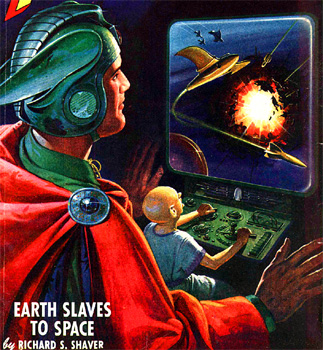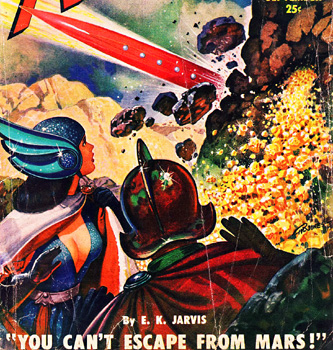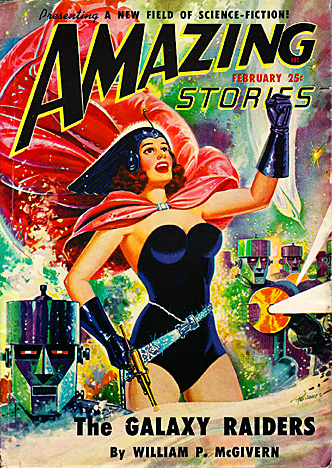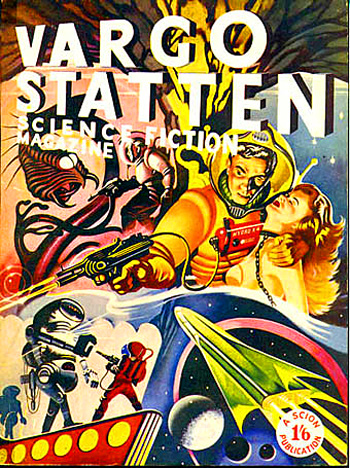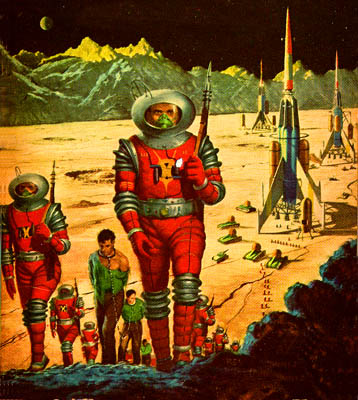
The Man Who Upset the Universe by Isaac Asimov (1952). Artwork by Ed Valigursky
Rise of the Rockets
Here's an example of how to play with the data in this site. Let's make an outline of the history of the Space Patrol.
Lets' make some assumptions. The Space Patrol more or less comes into being when rockets are capable of lifting off from Terra and doing round trips to planets (Before that, they were a glorified coast guard). There was a prior period of commercial orbit-to-orbit spacecraft, utilizing high Isp drives with thrusts of two or three humming-bird power. Those spacecraft looked like they were built of gossamer and cobwebs, and spacecraft combat was similar to encounters between Fokker Triplanes and Sopwith Camels.
For an example of a different set of assumptions, read Rick Robinson's Rocketpunk Manifesto essay The Time Scale of Space.
But now we have powerful rockets worthy of Tom Corbett and Rocky Jones. Assume that Space Patrol rocketships have mass ratios of 3.0. Assume that Space Patrol front-line rocketships always have the latest in propulsion, with commercial (and pirate) rockets having propulsion at best ten years behind, and much worse for tramp freighters. There will be some ancient commercial craft retro-fitted with slightly more modern propulsion, and the occasional criminal genius scientist with rocket propulsion ten or twenty years in advance of Patrol rockets.
Engine Table
| Year | Engine(s) | Δv at R3 (km/s) |
|---|---|---|
| 2050 | NTR-GAS 3rd gen | 65 |
| 2060 | NSWR 20% / NTR-GAS 4th gen | 73 |
| 2070 | NTR-GAS 5th gen | 110 |
| 2080 | NSWR 21% UTB | 150 |
| 2090 | NSWR 22% UTB | 200 |
| 2100 | NSWR 30% UTB | 800 |
| 2110 | NSWR 40% UTB | 1,500 |
| 2120 | NSWR 60% / Fusion 1st gen | 3,000 |
| 2130 | NSWR 80% / Fusion 2nd gen | 4,500 |
| 2140 | NSWR 90% / Fusion 3rd gen | 5,000 |
| 2150 | IC-Fusion 4th gen / AM 1st gen | 7,000 |
| 2160 | IC-Fusion 5th gen / AM 2nd gen | 10,000 |
| 2170 | AM-Beam 3rd gen | 15,000 |
| 2180 | AM-Beam 4th gen | 20,000 |
| 2190 | AM-Beam 5th gen | 30,000 |
For purposes of example, assume that advances in rocket propulsion occur at ten year intervals. You can play with the interval yourself later. In the table below, I tried to set of a progression of exhaust velocities (and thus delta Vs) that were somewhat evenly spaced. I made up the figures, only keeping them within the MAX ratings for that drive. For flavor I had some different drives with the same exhaust velocities. The main difference will be in what sort of power fuel is needed. To get the percentage of uranium tetrabromide for the NSWR, I did a simple linear interpolation. The actual types of engines was limited to those capable of giving a spacecraft about ten g's of lift-off acceleration.
The columns on the table to the right are, from left to right:
- The year the propulsion system(s) become available to the space patrol.
- The name of the propulsion system(s)
- The delta-v of the spacecraft with a mass ratio of 3.0 equipped with propulsion system.
Mission Table
Now we merge this information with Jon Roger's Mission Table. Each row corresponds to a year and a delta V max of that year's latest propulsion system. Using that delta V, consult the Mission Table, and see what is the maximum transfer orbit allowed under that delta V for each planet. You will come up with a table similar to the one below:
| Year | Luna | Mars | Venus | Ceres | Mercury | Titan | Saturn | Ganymede | Jupiter |
|---|---|---|---|---|---|---|---|---|---|
| 2050 | I1:33 (9d) | I1:60 (17m) | I1:61 (9.6m) | ||||||
| 2060 | I1:33 (9d) | I1:60 (17m) | I1:61 (9.6m) | I1:67 (2y7m) | |||||
| 2070 | I1:33 (9d) | I2:106 (2m) | I1:61 (9.6m) | I2:90 (7.5m) | I1:98 (8m) | I2:86 (4y11m) | |||
| 2080 | I1:34 (9d) | I2:106 (2m) | I1:61 (9.6m) | I2:90 (7.5m) | I1:98 (8m) | I3:113 (2y3m) | I2:112 (4y11m) | I3:134 (1y) | I2:145 (1y10m) |
| 2090 | I1:33 (9d) | I3:188 (1.5m) | I3:197 (21d) | I2:90 (7.5m) | I2:150 (2.5m) | I3:113 (2y3m) | I2:112 (4y11m) | I3:134 (1y) | I2:145 (1y10m) |
| 2100 | B3:520 (7h) | B1:740 (30d) | B1:562 (19d) | I2:90 (7.5m) | B1:794 (33d) | I3:113 (2y3m) | I3:217 (2y3m) | I3:134 (1y) | I3:236 (1y) |
| 2110 | B3:520 (7h) | B1:740 (30d) | B1:562 (19d) | B1:1,310 (63d) | B1:794 (33d) | I3:113 (2y3m) | I3:217 (2y3m) | I3:134 (1y) | I3:236 (1y) |
| 2120 | B3:520 (7h) | B2:2,230 (12d) | B2:1,630 (8d) | B1:1,310 (63d) | B2:2,410 (13d) | B1:2,842 (5m) | B1:2,840 (5m) | B1:2,002 (3.5m) | B1:2,000 (3.5m) |
| 2130 | B3:520 (7h) | B2:2,230 (12d) | B2:1,630 (8d) | B2:4,080 (23d) | B2:2,410 (13d) | B1:2,842 (5m) | B1:2,840 (5m) | B1:2,002 (3.5m) | B1:2,000 (3.5m) |
| 2140 | B3:520 (7h) | B2:2,230 (12d) | B3:5,104 (3d) | B2:4,080 (23d) | B2:2,410 (13d) | B1:2,842 (5m) | B1:2,840 (5m) | B1:2,002 (3.5m) | B1:2,000 (3.5m) |
| 2150 | B3:520 (7h) | B3:7,016 (4d) | B3:5,104 (3d) | B2:4,080 (23d) | B2:2,410 (13d) | B1:2,842 (5m) | B1:2,840 (5m) | B2:6,290 (32d) | B2:6,284 (36d) |
| 2160 | B3:520 (7h) | B3:7,016 (4d) | B3:5,104 (3d) | B2:4,080 (23d) | B3:7,588 (4d) | B2:8,958 (52d) | B2:8,954 (52d) | B2:6,290 (32d) | B2:6,284 (36d) |
| 2170 | B3:520 (7h) | B3:7,016 (4d) | B3:5,104 (3d) | B3:12,882 (8d) | B3:7,588 (4d) | B2:8,9580 (52d) | B2:8,954 (52d) | B2:6,290 (32d) | B2:6,284 (36d) |
| 2180 | B3:520 (7h) | B3:7,016 (4d) | B3:5,104 (3d) | B3:12,882 (8d) | B3:7,588 (4d) | B2:8,958 (52d) | B2:8,954 (52d) | B3:19,876 (12d) | B3:19,860 (12d) |
| 2190 | B3:520 (7h) | B3:7,016 (4d) | B3:5,104 (3d) | B3:12,882 (8d) | B3:7,588 (4d) | B3:28,320 (17d) | B3:28,306 (17d) | B3:19,876 (12d) | B3:19,860 (12d) |
Some notes on the table:
- All missions either start from Terra's surface or have Terra as the destination. (i.e., the "Mars" column gives data for both the Terra-Mars and the Mars-Terra missions)
- Transfer Orbit: I1 = Hohmann, I2 = Mercury-Pluto Big Ellipse, I3 = Solar Hyperbolic Escape +30 km/s, B1 = 0.01 g brachistochrone, B2 = 0.1 g, B3 = 1.0 g
- Delta V values for round-trip are in km/s
- Transit times for one-way-trip in parenthesis. Y = years, M = months, D = days, H = hours
Keep in mind the other big advantage of brachistochrone orbits: no launch window limits, you can launch anytime.
Jupiter takes more delta V to get to than Saturn does, even though Saturn is farther away. This is due to having to deal with Jupiter's massive gravity.
The same is true for Mercury and Ceres. In Mercury's case the culprit is the gravity field of the Sun. In Ceres case the culprit is the asteroid has no appreciable gravity to help with braking the orbit.
A History of Engines
In 2050, the Space Patrol first gets rockets that can theoretically do an Terra-Mars or Terra-Venus round trip, unfortunately taking one or two years transit time. It isn't until 2090 that rockets can reduce that time to a month or two.
The Asteroid Belt can be barely reached in 2060, with transit times reduced by 75% ten years later. Transit times don't improve again until 2110.
The outer solar system opens at 2080, but transit times don't become reasonable until 2120.
The 30% utb NSWR is a "torchship" as far as the inner solar system is concerned. The 2160 fifth generation Inertial Confinement Fusion drive is a medium torchship, and the 2190 fifth generation Beam Core Antimatter drive is a full torchship.
The Asteroid Belt is going to be a pretty lonely place until 2120. That's when commercial interests get their hands on a drive that cuts belt transit times from 7.5 months to two. After that, the Belt civilization will start to grow.
See how much of the future history just writes itself? Whip up your own table and have fun exploring the implications.

One in 300 by J. T. McIntosh, 1954. Artwork by Ed Valigursky 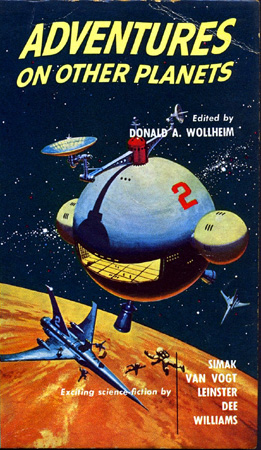
Adventures on Other Planets ed. by Donald Wolldheim, 1955


